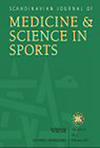Electrical Muscle Stimulation With or Without Blood Flow Restriction Does Not Prevent the Impairment in Glycemic Control After 1 Week of Physical Inactivity.
IF 3.5
2区 医学
Q1 SPORT SCIENCES
引用次数: 0
Abstract
Physical inactivity depresses glycemic control, an impairment that can be prevented with exercise. We investigated whether electrical muscle stimulation (EMS) with blood flow restriction (BFR) could similarly prevent the impairments in glycemic control associated with physical inactivity and whether this was effective for attenuating the loss of physical function after inactivity. Thirty-two participants underwent 1 week of step reduction (≤ 3000 steps/day) randomized to either no intervention (Control), twice daily EMS, or twice daily EMS with BFR (EMS + BFR). Oral glucose tolerance and tests of physical function (neuromuscular function, and cardiorespiratory fitness) were assessed before and after step reduction. Blood glucose incremental area under the curve (iAUC) during the oral glucose tolerance test increased after step reduction (Control: ∆71 ± 133 mM⋅min, EMS: ∆56 ± 65 mM⋅min, EMS + BFR: ∆103 ± 78 mM⋅min, p = 0.0002), as was the insulin iAUC (Control: ∆3580 ± 3245μIU⋅min/mL, EMS: ∆2266 ± 5043μIU⋅min/mL, EMS + BFR: ∆1534 ± 1246μIU⋅min/mL, p = 0.001). A relationship between the change in blood glucose and insulin response was observed after Control (r2 = 0.71, p = 0.002), but not after EMS + BFR (r2 < 0.01, p = 0.93), despite all groups demonstrating a reduction in whole-body insulin sensitivity (Matsuda index; Control: ∆-1.4 ± 2.5, EMS: ∆-1.3 ± 1.5, EMS + BFR: ∆-1.5 ± 1.5, p < 0.0001). Maximal oxygen uptake was not reduced after 1 week of inactivity; however, maximal isometric force production and exercise thresholds were reduced across groups. In summary, EMS + BFR did not prevent the decrease in insulin sensitivity nor attenuate measurements of physical function with 1 week of physical inactivity. The relevance of the dissociated insulin and glucose response with EMS + BFR remains to be determined.有或没有血流限制的肌肉电刺激不能预防1周不运动后血糖控制的损害。
缺乏体育活动会抑制血糖控制,而这种损害可以通过锻炼来预防。我们研究了电肌肉刺激(EMS)加血流限制(BFR)是否能类似地预防与缺乏运动相关的血糖控制损伤,以及这是否能有效减轻缺乏运动后的身体功能丧失。32名参与者进行了为期1周的步数减少(≤3000步/天),随机分为无干预组(对照组)、每日两次EMS组或每日两次EMS加BFR组(EMS + BFR)。口服糖耐量和身体功能测试(神经肌肉功能和心肺功能)在减步前后进行评估。口服糖耐量试验中血糖曲线下增量面积(iAUC)在阶梯降低后增加(对照组:∆71±133 mM·min, EMS:∆56±65 mM·min, EMS + BFR:∆103±78 mM·min, p = 0.0002),胰岛素iAUC(对照组:∆3580±3245μIU⋅min/mL, EMS:∆2266±5043μIU⋅min/mL, EMS + BFR:∆1534±1246μIU⋅min/mL, p = 0.001)。对照组后血糖变化与胰岛素反应之间存在相关性(r2 = 0.71, p = 0.002), EMS + BFR后无相关性(r2 < 0.01, p = 0.93),尽管所有组均表现出全身胰岛素敏感性降低(Matsuda指数;控制:∆-1.4±2.5,EMS:∆-1.3±1.5,EMS + BFR:∆-1.5±1.5,p < 0.0001)。不活动1周后最大摄氧量未降低;然而,各组最大等长力产生和运动阈值均降低。综上所述,EMS + BFR并没有阻止胰岛素敏感性的下降,也没有减弱1周不运动后的身体功能测量值。解离胰岛素和葡萄糖反应与EMS + BFR的相关性仍有待确定。
本文章由计算机程序翻译,如有差异,请以英文原文为准。
求助全文
约1分钟内获得全文
求助全文
来源期刊
CiteScore
7.90
自引率
4.90%
发文量
162
审稿时长
3 months
期刊介绍:
The Scandinavian Journal of Medicine & Science in Sports is a multidisciplinary journal published 12 times per year under the auspices of the Scandinavian Foundation of Medicine and Science in Sports.
It aims to publish high quality and impactful articles in the fields of orthopaedics, rehabilitation and sports medicine, exercise physiology and biochemistry, biomechanics and motor control, health and disease relating to sport, exercise and physical activity, as well as on the social and behavioural aspects of sport and exercise.

 求助内容:
求助内容: 应助结果提醒方式:
应助结果提醒方式:


